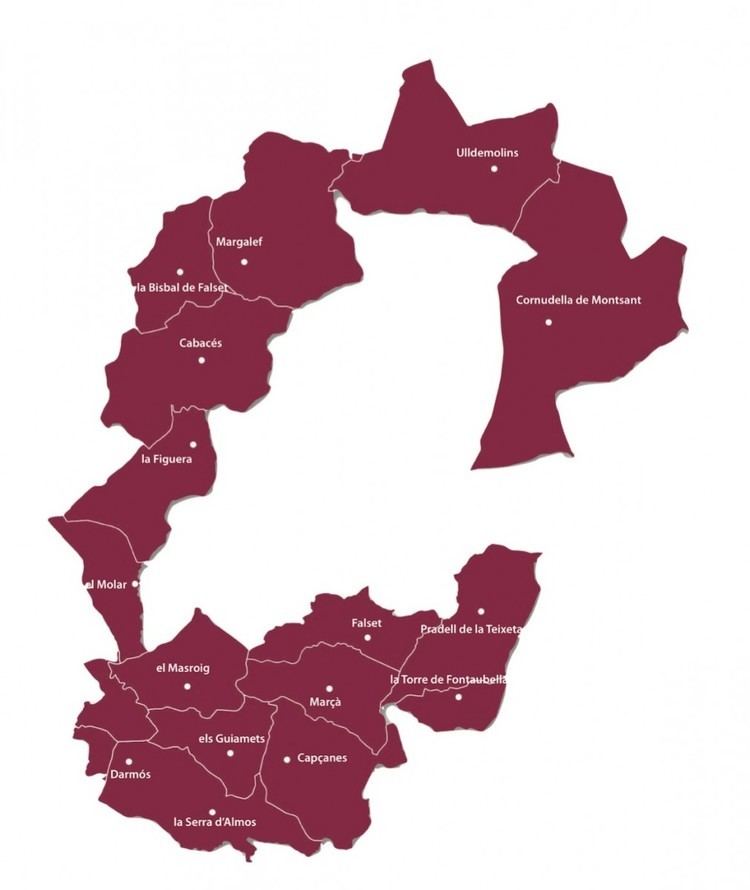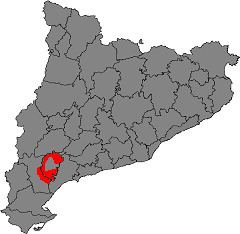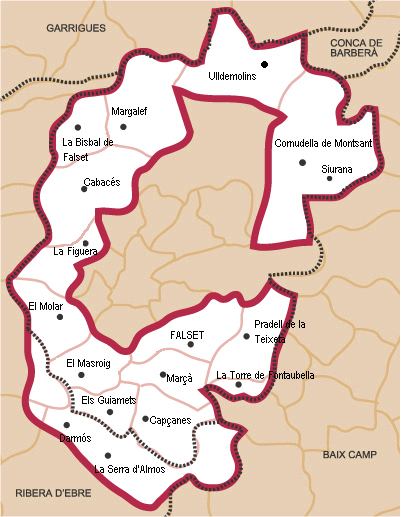Type Denominación de Origen Year established 2001 | Precipitation (annual average) 400–600 mm Number of wineries 57 | |
 | ||
Official name Denominació d'Origen Montsant No. of vineyards 1,857 hectares (4,590 acres) | ||
Montsant ([munsan]) is a Spanish Denominación de Origen, DO (Catalan: Denominació d'Origen) for wine located in the province of Tarragona (Catalonia, Spain) and covers 12 municipalities. It was previously known as the Falset subzone of Tarragona (DO), and was created as a separate DO in the early 2000s. Regional approval came in 2001, and from 2002 wines were sold as Montsant rather than Tarragona. Montsant takes its name from the Montsant mountains in the area.
Contents

There are currently about 1,857 hectares (4,590 acres) of Montsant vineyards. Under the auspices of the DO Montsant, the region has seen rapid growth, starting with 28 official cellars in 2002 which grew to number 57 currently. Approximately 94% of the production is of red wine with 62% exportation outside of Spain, 28% consumed in Catalonia, and 10% sold to the rest of Spain.

Geography

Montsant DO almost completely surrounds the more famous Priorat (DOQ). The vineyards extend along the mountainsides among olive groves, forests and rocky outcrops. The denomination covers the area of Priorat comarca that is not part of DOQ Priorat as well as part of the neighboring comarca of Ribera d'Ebre. In total, 17 villages are included: La Bisbal de Falset, Cabacés, Capçanes, Cornudella de Montsant, La Figuera, els Guiamets, Marçà, Margalef, El Masroig, Pradell de la Teixeta, La Torre de Fontaubella, Ulldemolins, along with portions of Falset, Garcia, El Molar, Móra la Nova and Tivissa (the sub-villages of Darmós and La Serra d'Almos.)
In 2014, the enotourism guidebook series, Vinologue published the first comprehensive guide to the all the regions of DO Montsant as well as profiles for all the full production cellars.
Soils

Vineyards range from 200 to 700 meters in altitude and sit on three main soil types: chalky clay, granitic sand, and slate. The altitude tends to increase towards the Serra de Montalt in the southwest and towards the Serra de Montsant in the northwest. There is a large degree of variation from the small, relatively flat plain around Falset and Marçà to the high altitude village of La Figuera that sits on a mountain range at 575 meters.
Climate

The climate is Mediterranean with continental influences. Summers are dry and annual rainfall is about 650 mm, falling mainly in autumn. There is only an occasional risk of hailstones or frost.
Grape varieties
The authorized white varieties are: Chardonnay, White Grenache, Macabeo, Muscat Blanc à Petits Grains, Parellada, and Xarel·lo. The authorized red varieties are: Cabernet Sauvignon, Carignan, Grenache, 'Hairy' Grenache, Merlot, Mourvèdre, Red Picapoll, Syrah and Tempranillo.
Wine styles
The main style of Montsant is powerful red wines, which can be similar to the wines of Priorat when they are made from old vine Grenache and Carignan. Production also includes white wines, rosé wines, sweet red wines and 'vi ranci' style wines made using a Solera system.
Kosher
DO Montsant has the distinction of being the only region in Catalonia (and one of only a handful) in Spain where Kosher wine is produced. There are two producers in the denomination, but the best known is Celler de Capçanes [1] who have been producing their Peraj d'Habib line with great success in a Kosher certified cellar within their main facilities.
